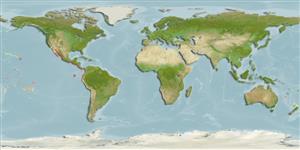Teleostei (teleosts) >
Anguilliformes (Eels and morays) >
Muraenidae (Moray eels) > Muraeninae
Etymology: Muraena: Latin, muraena = morey eel (Ref. 45335).
More on author: Jenyns.
Environment: milieu / climate zone / depth range / distribution range
Ecology
Marine; reef-associated; depth range 5 - 25 m (Ref. 9324). Tropical
Eastern Pacific: Gulf of California to Islas Lobos de Afuera, Peru, including the Galapagos Islands.
Size / Weight / Age
Maturity: Lm ? range ? - ? cm
Max length : 61.0 cm TL male/unsexed; (Ref. 5590); common length : 35.0 cm TL male/unsexed; (Ref. 57763)
Short description
Morphology | Morphometrics
Head and jaws very much compressed; body tapering posteriorly. Body depth at the middle about 1/13 of the entire length; the head about 1/7, measured to the branchial orifice. Jaws very narrow, sharp-pointed and equal. Gape deeply cleft. Teeth compressed at the sides, very sharp, slightly hooked and pointing backwards. Two tubular orifices above the eyes and two at the extremity of the snout. Distance of eyes from the end of the snout about twice the eye diameter. Branchial orifice and eyes of same size. Dorsal fin thick and fleshy. Color is fine dark purplish brown, with yellow circular spots; the spots mostly small. (Ref. 3157).
Often seen in shallow water. Remains under cover in rocky crevices during the day. Feeds mainly at night on crustaceans and fishes (Ref. 6852). Constantly opens and closes it mouth, an action required for respiration, not a threat (Ref. 5227).
Life cycle and mating behavior
Maturity | Reproduction | Spawning | Eggs | Fecundity | Larvae
Merlen, G., 1988. A field guide to the fishes of Galapagos. Wilmot Books, London, England 60 p. (Ref. 5590)
IUCN Red List Status (Ref. 130435)
Threat to humans
Harmless
Human uses
More information
Common namesSynonymsMetabolismPredatorsEcotoxicologyReproductionMaturitySpawningSpawning aggregationFecundityEggsEgg development
Age/SizeGrowthLength-weightLength-lengthLength-frequenciesMorphometricsMorphologyLarvaeLarval dynamicsRecruitmentAbundanceBRUVS
ReferencesAquacultureAquaculture profileStrainsGeneticsElectrophoresesHeritabilityDiseasesProcessingNutrientsMass conversion
Tools
Warning: mysqli::__construct(): (HY000/1040): Too many connections in /var/www/html/includes/speciessummary.lib.php on line 2414
Can't connect to MySQL database fbquizv2. Errorcode: Too many connections
